Overview of genera and their species
The arrowroot family has about 400 species. They are divided into 30 genera. The most popular of them are arrowroot, calathea, stromant and ktenanta. Care, as well as maintenance, all of them require approximately the same. Florists note that there are no particular difficulties in growing, but it can still be difficult for beginners.
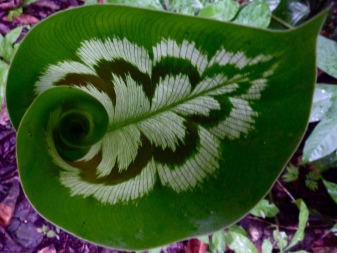
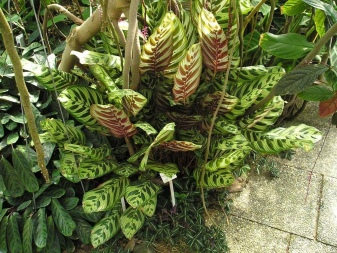
Arrowroot
When it comes to room arrowroot, it is capable of reaching a height of only 20-30 centimeters. In the wild, this plant grows up to 1.5 meters. Among the features, one can note the presence of rather short lodging shoots.
It is the arrowroot that is considered the flower that requires the least care. Indoor plants can not always please the owners with flowering. If this happens, the buds are quite small, with petals of pale lilac or white.
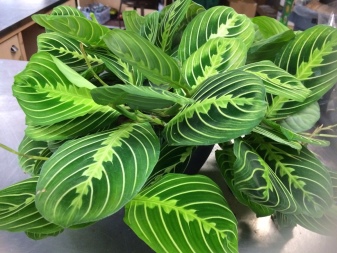
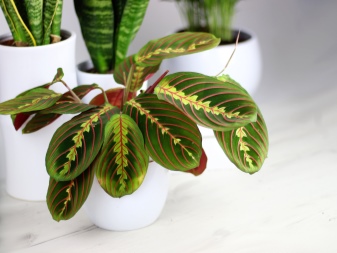
Among indoor plants, there are 7 varieties of arrowroot. Most often, flower growers choose tricolor or two-color, Kerhoven's arrowroot or Massange.
Tricolor can be called the most popular. It has leaf plates with bright red veins that are pink underneath. Around the stripes there is a yellowish or pale green halo, spreading in spots to the edges and at the same time becoming darker and darker. Bicolor is distinguished by reddish-brown petioles and slightly wavy edges. There is a small fluff on the bottom of the leaves.
For inexperienced growers, the easiest way is to grow Kerhoven arrowroot. She is the least moody and does not require serious care. However, it looks no less bright and extravagant than other varieties.
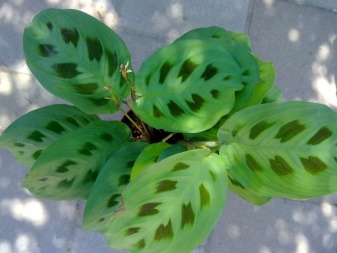
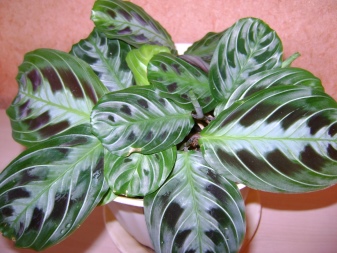
Calathea
This variety has wide leaves with a spectacular and bright pattern of all kinds of shades. The pattern consists of spots and stripes. Such plants look very original, but you will have to take care of their care.
Calathea is quite tall and slender. It can be grown in an ordinary flower pot if desired, but experts recommend placing the plants in a terrarium or organizing a "bottle garden" for them. They are moody enough, they do not tolerate drafts. Very sensitive to what kind of water will be used for irrigation. For active development, they need air with a humidity in the range of 85-100 percent.
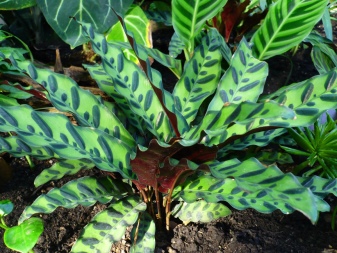

Some varieties react very negatively to the spraying procedure. They cannot be kept under the shower for a long time. They can have both beautiful, original shape and nondescript leaves. However, they are distinguished by bright flowering. The most popular are the saffron calathea, Makoya, painted and pinkish-colored.
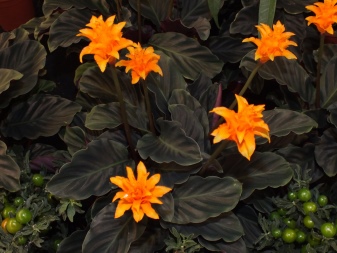
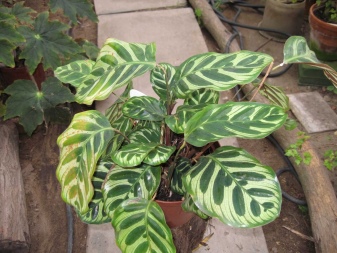
Stromant
Outwardly, this plant resembles an arrowroot, but the color of the leaves is closer to the calathea. It can reach a size of 70-80 centimeters in height, while the leaves grow up to 20-35 centimeters. Their background can be anything. Some are distinguished by the variegation or brilliance of satin. The lower part has a burgundy tint.
Stromant can be called a plant for which conditions of maintenance and care are most important. Includes 13 varieties, but few take root at home. The most popular are stromanthus pleasing and blood-red.
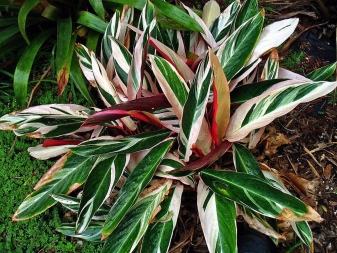

Ktenantu
The leaves of this plant are arranged in a dense rosette, the tiers of which are divided using internodes. I must say that outwardly the flower resembles a calathea. It is quite whimsical to the conditions of detention, therefore it is not recommended for growing for beginners.
The leaves are rather large, oval or oblong in shape. They are asymmetrical, which is what often differ from other members of the family. They cannot boast of abundant flowering, and the inflorescences do not look very impressive. Among indoor plants, the most popular was the Oppenheim variety.
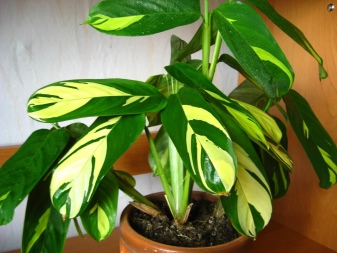
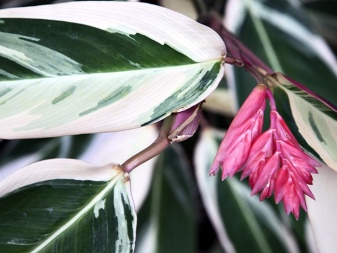
Varietal varieties of arrowroot
"Fascinator" (M. leuconeura Fascinator). or "Tricolor" (M. tricolor)
The most famous variety, referred to as the "tricolor" by pot plant sellers. Sometimes it is found in popular scientific publications about indoor floriculture, like arrowroot red-tipped. On the leaf, 3 colors are clearly visible: a dark green velvet background in the middle of the leaf, light green along the edges and crimson contrasting veins. The leaf has a peculiar pattern - 10 dark spots that form the background. For this color, the plant is popularly called "10 commandments", and for the peculiarity of turning the leaves behind the sun, raising them or lowering them, as if "bowing" depending on the lighting, the flower is called "prayer grass".
Many people see the backbone of the fish in the color of this arrowroot. The bush grows in width and height up to 30 cm, the stems are not standing straight, but as if hanging. Petioles of leaves have an interesting growth - "along a broken line". flowers are small, light lilac.
"Massange" (M. leuconeura Massangeana)
Refers to "black" arrowroot for a very dark color in the middle of the leaf plate. The drawing on the leaf is contrasting, consists of a green background along the edges of the leaf, on the sides of the central silver vein, light green-green stripes of lateral veins protrude as an edge.
Between them are bright brownish-green strokes. The plant is very compact, miniature, only 15 cm high. In care it is considered the most capricious arrowroot.
"Marisela" (M. leuconeura Marisela)
A very similar variety to M. "Massange". Differs in a darker green main background. The toothed pattern is preserved only near the central vein, the lateral veins are almost not distinguished.
"Kerhovena" (M. leuconeura Kerchoveana)
Tall and sprawling plant. Leaves are elongated, elliptical, 12-15 cm long, sitting on short petioles. Very bright color of the leaf plate: dark brown strokes and eyes are located on a bright green background.
The spots on the sheet are always clear, they do not merge into a solid line. Below, the leaf is colored bluish and reddish. Arrowroot height -25 cm. Flowers are small, inconspicuous, collected in 2-3 flowers, lavender. The veins on the leaf are not embossed and are not distinguished by color. An unpretentious variety is often used in landscaping offices and institutions.
Leuconeura Beauty Kim
The leaves are smooth, heart-shaped or oval, with a pointed edge, have a viral variegation. The main background is light green, with dark green clearly traced spots. On the entire surface of the leaf, there are strokes, stripes of light green, pale yellow or white.
Some leaves may be half white. All strokes, white spots and stripes are located along the central and lateral veins of the leaf. The veins themselves are poorly expressed.
"Emeral Beauty" (leuconeura Emerald Beauty)
It is similar in color to the "Beauty Kim" variety. The same viral variegation, but the pattern is very blurred, the background has no contrasts, there are no dark green spots. The leaves are very shiny, but appear just green from a distance.
The genus of arrowroot is not limited to these representatives and has more than 20 species of tropical herbaceous plants. The listed species and their varieties have bright leaf color. The rest are botanical species that did not take root on the windowsills of amateurs, possibly due to difficult agricultural techniques and the difficulty of getting a rare specimen.
Types of arrowroot
Arrowroot / Maranta leuconeura
It occurs naturally in the tropics in the Brazilian moist forests. The root of the white-stemmed arrowroot is tuberous; the stem grows up to 30 cm in length. The leaf petioles are not more than 2 cm in length. Leaves - up to 15 cm long, up to 9 cm wide - rounded-elliptical and heart-shaped at the base; the underside of the leaf plate is reddish or gray-green, and the upper side is covered with light green patterns and white veins on the dark green background of the leaf. Most often, varieties of this species are grown in room conditions - Kerchoveana, Massangeana, tricolor or leuconeura.
Arrowroot bicolor / Maranta bicolor
This species does not form tubers.Leaves are oval in shape and slightly wavy edge attached to short petioles, grow up to 15 cm in length; from above the leaf is green with brown spots along the central vein, and from below it is reddish and covered with hairs.
Maranta kerchoveana / Maranta kerchoveana
White-necked arrowroot diff. Kerhovena (Maranta leuconeura var.kerchoveana) is a herbaceous perennial, reaching a height of 25 cm. The leaf petioles are short. Leaves are oval up to 15 cm long; the upper side of the leaf plate is bright green with a white stripe along the central vein and dark green spots along the entire surface of the leaf. The underside of the leaf plate is colored in a shade ranging from reddish to bluish. Arrowroot flowers are white-streaked white, two or three flowers per inflorescence are collected.
Maranta Massangeana
White-necked arrowroot diff. Massange (Maranta leuconeura var. Massangeana) - almost no different from the Kerhoven variety, except for the color of the spots on the leaves - they are olive brown.
Arrowroot tricolor (tricolor) / Maranta tricolor
White-necked arrowroot diff. tricolor (Maranta leuconeura var. tricolor) - another name - white-necked arrowroot var. red-leaved (Maranta leuconeura var.erythrophylla). The leaves are pubescent, oval in shape, grow up to 13 cm in length, and up to 6 cm in width; the upper side of the leaf plate is from light to dark green with red veins and light green spots along the central vein and feather-like dark green spots along the lateral ones. The underside of the leaf is crimson with pink veins. The flowers are light lilac.
Arrowroot / Maranta arundinacea
This species is a shrub, reaching a height of up to 1 m with a little. The roots are tuberous and thick. Leaves up to 25 cm long, ovoid and slightly pointed at the top. The underside of the leaf is dark green and covered with hairs. It blooms with white flowers.
Jasmine (Jasminum) - care, photos, species Orchid roots rot, dry - what to do?
After this article, they usually read
Add a comment
Growing problems
- The ends of the leaves are brown and dry, stunted growth is a possible reason: the air is too dry or the plant is too dry. Another reason is the quality of the water (a lot of salts, chlorine, fluorine, hardness). Also check to see if the plant is infested with spider mites. Remove dead leaves, keep humidity above 50%.
- The ends of the leaves are yellow-brown - with an excess or lack of nutrients in the soil. Do not get carried away with fertilizers, especially if you have good quality soil. At the same time, emaciated plants have pale small leaves, and no additional feeding is required, but a transplant.
- The leaves curl up, the lower leaves turn yellow - a possible reason: insufficient watering. The soil should not dry out too much, especially if the temperature is above 26 ° C.
- Sluggish stems, drooping shoots - if it is too cold and / or too wet for a long time.
- Leaves lose color, turn pale, discolor and dry out - under too intense sunlight, when the afternoon sun hits the leaves, or when mites attack.
How to grow arrowroot at home: how to care for a plant during dormancy and flowering
At home, caring for an arrowroot flower is not so difficult - the plant is not very demanding, and in order to provide it with the necessary environmental conditions, you do not need to make much effort.
The flower needs bright light with shade from direct sunlight. Exposure to the sun is bad for this plant, so the arrowroot will begin to curl the leaves, which can confuse its owner. The best place for her is north, east or west windows.
In winter, arrowroot as a houseplant is no different from most other house flowers - it needs additional lighting with fluorescent lamps. Otherwise, the shoots will begin to stretch, and the leaves will shrink, which will ruin their decorative appearance.Too much light can negatively affect the color of the leaves - they get a pale shade. This may also be the reason why the arrowroot turns yellow, since the plant tolerates a slightly shady habitat much better.
Arrowroot is moderately thermophilic, it must be protected from drafts, otherwise the leaves will begin to dry. Dislikes sudden temperature changes. In the warm season, the flower will feel best at 20 - 25 ºC. In autumn and winter, the temperature should be reduced to 18 - 23 degrees. If it falls below 12 degrees, the flower may die. In winter, the room temperature should be at least 18 ° C. The soil in the pot should never dry out.
Do not put this plant pot on a cold floor or windowsill. If weather conditions permit, arrowroot can be taken outside, but it is necessary to find the right location - without drafts and direct sunlight.
This flower feels good in moderate humidity. If the air in the room is very dry, the plant should be sprayed frequently. In addition to spraying, there are several other ways to increase the moisture around the arrowroot. You can put the pot on a pallet with wet pebbles or expanded clay. But the roots should not be allowed to touch the filling.
You can also simply place a small container of water near the flower. On days when the air temperature rises above normal, the plant must be gently rinsed under the shower
It is important to cover the soil with plastic before this procedure. If the air in the house is too dry, the pattern will cease to be distinct, the leaves will lose their tone, and their tips will begin to die off.
Before you start caring for arrowroot, you need to remember that home conditions are not entirely natural for her, and in her native lands she lives in wet areas near water bodies, in wetlands. Therefore, it is desirable to bring the conditions of its growth closer to natural ones. To do this, use the tips below.
As you could already understand, this plant loves moisture. During the period of growth and development (spring and summer), arrowroot needs abundant watering. It is better to cover the soil in a pot with damp moss. With insufficient watering, the flower wilts and can dry out completely. However, excess moisture is also very harmful - it can lead to rotting of the root system. A particularly high probability of such an outcome appears at low air temperatures and heavy soil.
In winter, watering should be moderate. It is better to use water at room temperature. It is imperative to make sure that water does not fall on the leaves when watering, as this will lead to the appearance of fungi.
In the warm season, every two weeks, arrowroot should be fed with flower fertilizers, the concentration of which should be two times lower than indicated on the package. It is best to have a fertilizer nutrient ratio (NPK) of 3: 1: 2. If in the winter season the temperature and light conditions remain optimal, the plant must be fed once a month. However, if the plant is dormant, feeding is not necessary.
Flowering is not the main advantage of arrowroot, therefore, often only the bud that has appeared is cut off so as not to tire the plant once again. However, at home, this genus rarely blooms, so this is a whole event for some growers.


